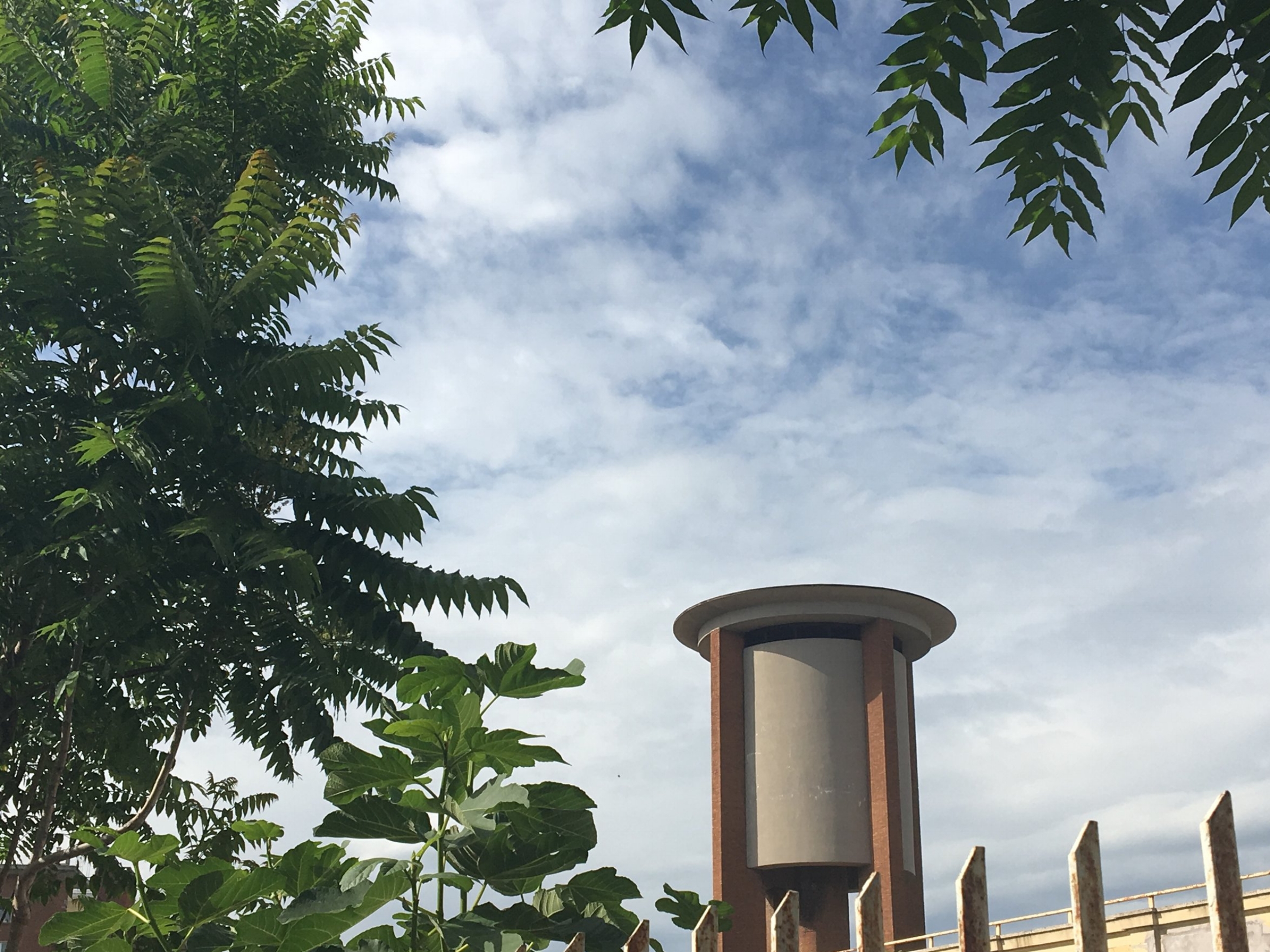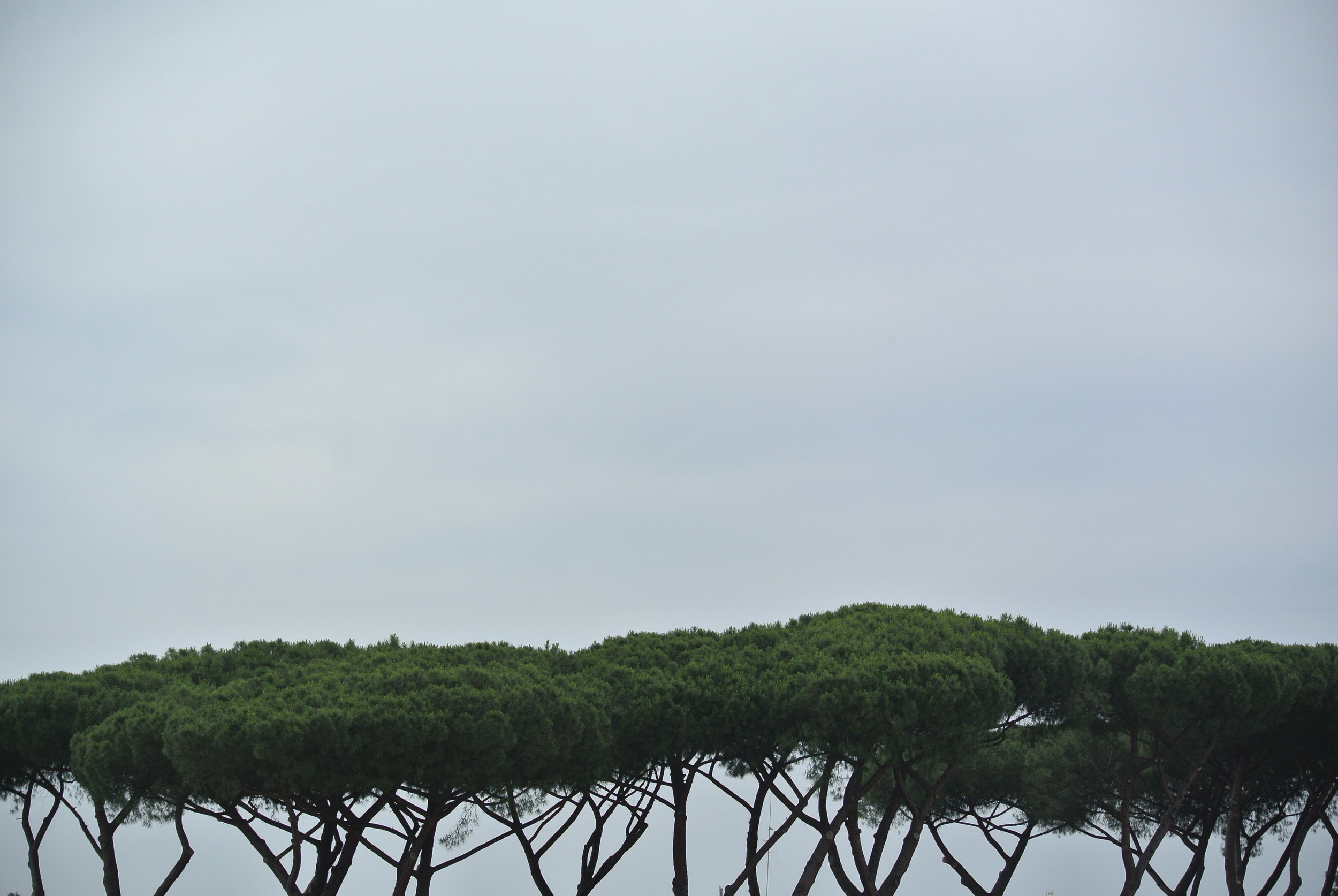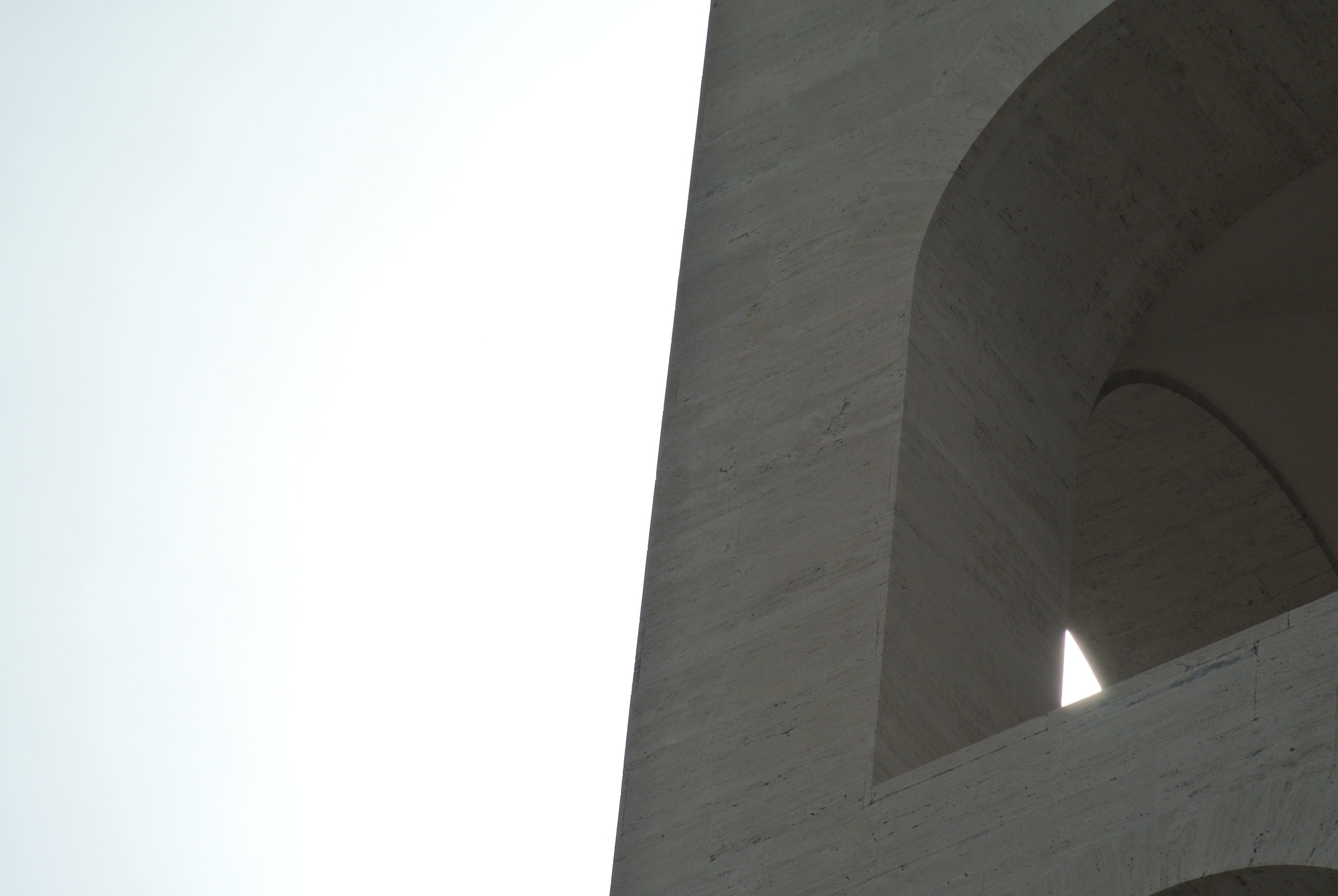MotM Photo Essay | Rome: Alien To Itself
UFO: graffiti at a pedestrian portal. Rome, Ostiense; June 2018. ©Pamela Kerpius
26 June 2018
MotM Photo Essay
They've Landed
I left Lampedusa and landed in Rome when it was still mid-spring 2018, relieved at the lack of wind and grateful for the city noise that would normally keep me awake. The noise just meant the jet from the forgotten island made it through the outer layers of the atmosphere, and that I was back on Earth.
I took the apartment of a friend on the south side of the city this time. There are no tourists there. It is what a lot of friends have said to me is the “real Rome.” It is residential. It is working class. It is, I think, some equivalent of select pockets of Brooklyn. But it is not Earth.
Spaceship Parking: rooftops ready for liftoff. Rome, Portuense; May 2018. ©Pamela Kerpius
The buildings are all the same. Squares with seven floors, maybe eight, and terraces that encircle the outer face of the building like gills that let the terrestrial fish breathe. I was on a high floor. You see something from there that you can almost never see in the city of Rome, skyscrapers.
Images of a futurescape: they were all living out there in EUR, the area of Rome that Benito Mussolini planned with his fascist touch of efficiency. Wide boulevards, flat paneled marble facades, everything made in the aspect of functionality, which is to say, a galling antithesis to the rest of Rome.
The Mothership: she keeps watch over the space colony. Rome, EUR; May 2018. ©Pamela Kerpius
These are alien structures with eyes. The trees look alien in the city though too, they always have, I’ve thought. The rooftops all over, from across the street to across the river in the distance look like flying saucers. There is an old tower in EUR that might really be a spaceship. In the distance, there is the Telecom Italia tower pointing up from the ground like the Space Needle in Seattle, but with longer tines and more intent. There are poles reaching out from everywhere. Antennas on every roof. Poles of wire. Nets of wire. Wires over the street corners leading the trams. Steel tracks in the street.
Parabolic Passages: deformed driving guides through the circular space colony. Rome, EUR; May 2018. ©Pamela Kerpius
There are many means of travel in Rome but it is hard to move. Anywhere from outside of the center is slow to navigate. Not all the subway lines come here. There are too many cars. Buses enter the fray. You feel like you might never get there.
Besides, you cannot move in a straight line in Rome. Everything goes in circles. Movement from point A to point B takes a parabolic swing, never in direct course, and sometimes, the perspective of the path from the passenger seat of a car might feel like you are actually shifting in a spiral toward the event horizon.
Satellite Station: a flying saucer flood lamp dots the space colony. Rome, Garbatella; June 2018. ©Pamela Kerpius
This is an embellishment, but “Porca troia,” friends will shout from the drivers’ seat, some being native Roman perhaps. An unanticipated VARCO ATTIVO detour sign to cut car traffic on behalf of pedestrian congestion is inevitable and sneaks up on all. Drivers will have billowed up into a frenzy of curses then fall slack, exasperated by a task that was supposed to be intuitive.
That switch of emotions flickers on and off over the course of a drive, which is maybe stopped from time to time in the middle of the street to see where it all went wrong. I’ve seen, on the other hand, a honed deadpan from drivers who are more practiced in the art of surrender. Their last sign of life, the blue glow of the GPS screen reflected in bovine eyes. Occasionally, cab drivers are not even immune.
Alien Capsule: resting at the docking station. Rome, Tiburtina; June 2018. ©Pamela Kerpius
The ring of Rome, a highway that circumnavigates the city, gives way to arms that cut into the center, routes established from ancient times: via Salaria, via Appia, via Flaminia, etc. “All roads lead to Rome,” they still do, even if it is hard to recognize. Via Aurelia is the one I can navigate best, because I’ve learned where the tree roots erupt the asphalt and to change lanes before it so the car axle stays in place.
Potholes are more difficult to predict because they could appear anywhere, and in that sense they are easy to predict because they are everywhere. In late May, the Giro d’Italia bike race was cancelled in its last laps through Rome because the city's botched roads threatened the safety of cyclists.
Alien Outgrowth: lamplight tentacles reach through the trees. Rome, EUR; May 2018. ©Pamela Kerpius
Surrounding it is an overgrowth that is swallowing the final remains of this civilization. Weeds take over parks. Grasses grow in knots along the roadsides. It would literally be “The World Without Us,” an image of what it would be like to be alive in the post-human era when all has fallen to disuse and nature takes over, except that here there is too much trash and graffiti contaminating the surface for that organic picture to be complete.
Meet George Jetson: pine trees on stilts to the stratosphere. Rome, EUR; May 2018. ©Pamela Kerpius
This sounds like an embellishment too, but the most sophisticated plan to curb the overgrowth put forth by the current mayor of Rome, Virginia Raggi, so far is to import grazing sheep. I think: a lawnmower might do. Which would also create a job or two.
C'era Una Volta: alien inscriptions from a long ago age. Rome, EUR; May 2018. ©Pamela Kerpius
But this is the city of Rome. And it should read as an account statement that allows us to see what exactly is wrong in this atmosphere, which is not the same as a justification for that which is preventable here: its collective hope for the future dashed.
In spite of Rome’s civic and spiritual deadlock, it is perhaps because of its overgrowth, municipal disuse, citizen frustration, and out-right abandonment (as we see with Piazza Indipendenza) that there is an opportunity here for an outsider.
Alien Extremities: maybe the trees are their toadstools. Rome, EUR; May 2018. ©Pamela Kerpius
This alien body of Rome as we know it outside the tourist center looks like it’s ready-built for outsiders. Black skinned migrants are shunned and exiled to tent camps beside Tiburtina station, but why should an African feel foreign to Romans when the city already appears to have been inhabited by aliens from outer space. Who is Rome? Maybe it’s just the circular nature of things––objects, streets, bureaucracies that divert direct address to the thing that’s right in front of you. Maybe you can never land on a plan when there’s no atmosphere to contain the angry projectiles put in motion by this sphere’s centrifugal force.
Extraterrestrial Toadstools: open seats in the sky. Rome, EUR; May 2018. ©Pamela Kerpius
One friend said it is bureaucracy (all of its offices headquartered here in the aged future, the capital city, Rome) that can be the best tool to achieve a political outcome. It keeps the paperwork in a holding pattern. Slow down the bureaucracy, delay the outcome you do not want to see.
The case of Jugend Rettet (Youth Rescue), the German NGO vessel that was seized by Italy last year, is an excellent example.
Into The Ionosphere: martian structures collide with cosmic rays. Rome, EUR; May 2018. ©Pamela Kerpius
We met in Piazza Cavour on 23 April 2018, after they had convened with their lawyers and pleaded before the Italian court. Julian Pahlke, Jugend Rettet Chairman, and Isabel Grahn, its press coordinator, smiled at our meeting of solidarity, but it was just as much one of exhaustion for what they had had to endure so far within the system. The next day, the verdict was announced that their ship would stay impounded on suspicion of their collusion with Libyan traffickers at sea, an unfounded claim that has now plunged them into a lengthy appeals process and consequently––and to the delight of anti-immigration policy advocates––out of the SAR zone in the central Mediterranean.
Alien Antennas: space colonists ready to receive transmissions. Rome, Portuense; May 2018. ©Pamela Kerpius
So I was thinking about the dejected Roman mindset that has been governed by this kind of passive policy as I observed the capsule-shaped rooftops, antennas, and flying saucer-shaped trees this spring. It was a landscape that did not work because its keepers lost accountability, which is the same as losing your identity––without it, you are adrift with no history. Rome, it was clear to me, had become an alien to itself.
Wreckage Of The Forsaken: flotsam from the spaceships with unknown hieroglyphs. Rome, Portuense; May 2018. ©Pamela Kerpius
Its broken roads, weedy corridors, uncollected trash, and bureaucratic inefficiencies have been clung to as a rationalization for why it––as a city, as a people––cannot move forward, rather than as a reason that motivates it into action. Its vision is so hindered that it cannot see that the solutions to its problems are right on its own surface.
To wit, Prince, a migrant from Nigeria on a street in south Rome as he swept up piles of the litter on the street, “I have to stay busy and I want to give back.” He left a donation cup at the end of the row where he worked.
So after all, there is somebody in Rome with a vision and the will to act upon it. There are others who have landed too.
Read the Followup Essay: a recap of the migrant encounters in Rome in spring 2018 >














